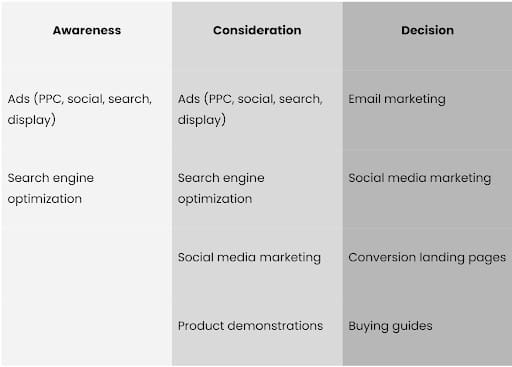What Impacts Conversion Optimization Efforts

Marketing professionals know about conversion funnels—aka sales funnels. At the top, there’s a big opening that many consumers slide into. But as the funnel narrows, conversion optimization works on fewer and fewer consumers, resulting in the fallout of sales at the bottom.
Obviously, organizations want to increase the efficacy of their funnels. Driving more leads into the top results in more sales at the bottom. But widening the funnel so that more leads fall all the way through can also be a viable strategy for increasing sales. This post explores the relationship between customer journeys and conversion strategies and provides some tips for optimizing conversions.
Buyer’s Journeys and Conversion Funnels
All customers go on a journey before they make a purchase. It doesn’t matter if someone is buying a $5 value meal or a $5,000 appliance for their home. The journey may take seconds or months, depending on the purchase, but it involves what many refer to as the buyer’s journey:
- The person becomes aware of a need or desire. Someone’s stomach growls, and they realize it’s lunchtime. The refrigerator is acting up, and the family knows they should start shopping for a new one soon. For whatever reason, the consumer has become a buyer and is actively on a buying journey.
- The buyer gathers information and considers options. In the case of lunch, that might mean scanning the menu or choosing from various take-out options. In other cases, consideration may involve learning and researching, saving money, and comparing options over a long period of time.
- The consumer reaches out specifically to one or more businesses. They place orders, complete demonstrations, or get quotes. Finally, the decision is made. The consumer converts to become a customer for a specific business.
- The buyer’s journey extends beyond the first purchase, though. Depending on a business’s model, it may have an opportunity to continue conversion optimization to build repeat business, loyalty, and advocacy.
Conversion funnels follow the overall outline of the buyer’s journey. At each phase in the buyer’s journey, there are opportunities for converting someone—guiding them into the next part of the funnel. And at each of those borders, the funnel becomes smaller.
The Role of the Customer’s Journey
While many people use the terms buyer’s journey and customer’s journey interchangeably, customer journey can mean something much more specific. It can refer to the messier path that each customer takes to make a buying decision.
Here’s one example of how customer journeys can be different for individual consumers: Imagine a legal firm that offers divorce services.
Someone considering a divorce might start researching the topic online. Because of the keywords they’re using and their geolocation, the firm’s search ads show up. The individual clicks on a search ad and signs up for a free download of information, handing over their email for marketing purposes in the process. The firm launches an email marketing drip campaign, and in a few weeks, the individual clicks to make an appointment for a consultation from one of those emails.
Now imagine the same firm. This time, a couple wants to get a non-contested divorce. They ask for recommendations of local law firms on Facebook, and someone suggests this firm. The couple reviews the firm’s website and makes an appointment.
These are two different customer journeys. But each does go through the conversion funnel.
Using This Information to Create Better Customer Journeys and Conversion Optimization
By understanding how all these factors work and relate with each other, brands can maximize versions at every part of the funnel. Check out the tips below for doing so.
Align Marketing Efforts With the Right Part of the Funnel
Brands should ensure that their marketing and sales efforts are aligned with each part of the conversion funnel. That means ensuring the steps in the customer journey—regardless of the path someone ends up taking—push consumers through the funnel at the right time.
For example, PPC or search ads are generally top-of-the-funnel efforts. They capture the interest of people who are just becoming aware of a need or still gathering information during consideration stages. PPC ads aren’t the best option for low-level conversion efforts because someone that’s already reached the bottom of a conversion funnel is:
- Less likely to start their final buying process in the search engine
- Already connected with potential businesses
- Note typically looking to find out about another brand or business
On the other hand, email marketing is usually more effective when it connects with the customer journey further down the funnel. The following list categorizes some common types of advertising and marketing efforts by where in the funnel they may work best as conversion tools. Some of them work across two or more parts of the funnel, and it does depend on the products and audience in question.

Research Buyer Intents and Support Them
Strong content optimization requires an in-depth knowledge of a brand’s target audience and buyer intents. The table provided above is a general example, and businesses that understand their buyer intents can modify marketing approaches to connect with consumers in the best possible way.
For example, a company that sells an instant-gratification, low-cost product like funny socks might know that its target audience is more likely to purchase on whims than plans. That moves social media and PPC ads deeper into the traditional funnel as the customer journey might be: See add, click, and buy.
Use Efficiency and Convenience for Conversion Optimization
When brands fully understand their audience’s intents and needs, they can also optimize conversions by supporting efficiency and convenience along the customer journey. One example is mobile-friendly sites and ads, particularly for businesses that rely on in-the-moment searches and purchases.
By understanding customers’ journeys, businesses can find important points along the conversion funnel to strengthen. And when those touchpoints are attended to, increased sales and revenues often follow.





